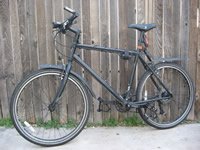Something important to know is that wind jackets don’t breathe very well; if they did, they wouldn’t be windproof. This means during exercise and activity – like biking – you may feel a damp sensation along the inside of the jacket. This is your body’s perspiration condensing along the material that it’s struggling to pass through. However, most jackets will have pit zips that allow for decent ventilation.
A fun bike commuter fact about pit zips: you can use them for ventilation even when wearing a backpack. Most cycling-specific jackets have a horizontal flap along the back for ventilation. Trouble is, the flap doesn’t work so well if it has a backpack covering it.

I own the REI Swift Jacket. It’s rated to be windproof in conditions as high as 60 mph. The fastest I’ve gone on my bike is 35 mph and the Swift Jacket did a great job keeping the chilly, fast-moving morning air off my body. It has a longer tail in the back (great when I’m hunkered over the handle bars), elastic cuffs that fit snuggly at the wrist, and wide-opening pit zips under the sleeves.
A couple other great options to look at are the Marmot Ion and the Salomon Fast Wing. They have the same basic design as the Swift except that both the Ion and the Fast Wing also have hoods that roll away into the collar and they both stuff into a chest pocket for compact storage. From just trying on these two products, they both seem to be as windproof as the Swift.
Curious to know how windproof a jacket is? Here’s a little test you can do:
- Put your hand inside the jacket, flat against the material.
- Put you mouth directly against the same area of material.
- Blow as hard as you can “through” the material, against your hand.
I know what some of you are thinking: "It’s summer in Albuquerque, 90 degree days with cloudless skies and blazing sun. Why are we talking about jackets?"
The fact is most of us commute in the morning when the air is still chilly from the cool desert nights; it may be 90 at lunch time, but temperatures still bottom out around 50 at night. What’s more, there have been plenty of afternoon showers and blustery winds recently. Not to mention that monsoon season is still in our future.
With this in mind, packing wind and rain protection for under 6 oz and around $50 is a fantastic idea for all of us who commute.



No comments:
Post a Comment